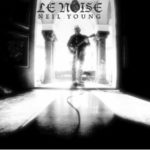
Reprise Records
Oh, Neil … another fork in the road that’s not just an album title – and another yank of the wheel in a direction that no one was expecting. (Although after over 40 years of doing other than what the public thinks he should be doing on a fairly regular basis, why is it a surprise anymore?)
Maybe the big question is, after several decades, when does a steady series of detours cease to be thought of as such and simply become the journey itself? Maybe the release of Le Noise is a good time to start.
This time around, what we have is a solo album that’s not really a solo album. Sure – the basic sounds on Le Noise are ol’ Neil and his guitar, but sonic master Daniel Lanois shapes things in a way that goes beyond the basic role of a producer. Even Lanois’ house deserves some sort of credit – there are parts of Le Noise that only sound the way they do for having been ricocheted around the ceilings or piped down into the basement and back.
(Total side note/teaser/spoiler: if you like the production on Le Noise, boys and girls, keep an eye out for the upcoming album from Lanois’ Black Dub project. There are a few more hands involved in making the actual music, but the same sort of sound-shaping takes place.)
Two of the eight tracks on Le Noise feature Young on acoustic guitar with just-right pinches of ear spice from Lanois. Be prepared for the back rooms of guitar stores across the land to be full of pickers showing off their chops with covers of “Love And War”. The song’s lower-string runs rival those on “My My, Hey Hey” and occasional bittersweet Spanish-flavored riffs serve to pound home lyrics about … well, love and war, actually. “When I sing about love and war I don’t really know what I’m saying,” says Young. “I’ve been in love and I’ve seen a lot of war, seen a lot of people praying.”
“Peaceful Valley Boulevard” paints big, sprawling images in your head, from wagon trains that “rolled through the dusty canyon, the settlers full of wonder as they crossed a gentle creek where two old oaks were standing” to a lone polar bear “drifting on an ice floe, sun beating down from the sky.” Again, Lanois knows that sometimes a good chef only needs a dash of seasoning to make a dish work – he accents Young’s sound on “Peaceful Valley Boulevard” without getting in the way of the song.
And then there are the other half-dozen tunes on Le Noise, where we find Mr. Young with either his battered-but-beloved Les Paul (“Old Black”) or faithful Gretsch White Falcon strapped around his shoulders. Anyone who caught any of his live shows this year is already familiar with the concept: “_I_ said solo; they said acoustic.” Even in the studio setting of Le Noise (or house setting, to be accurate), these performances are live – the extra layers, colorings, aural mists, light, and darkness were all produced by Lanois as he manipulated the sounds Young was making in the middle of his living room.
Songs range from those long-loved by Rusties but never released (the brutally-honest dope bio “Hitchhiker”, which ends with Young as survivor, “thankful for my children, and my faithful wife”) to the Le Noise-cultivated “Walk With Me” or “Rumblin’”. There are no long guitar solos to be found, but there is plenty of guitar sound – and the novelty of there being no drums, no bass (and sadly, no Ben Keith, God rest his soul) gives way not long into the album, allowing you to simply hear the music.
The results are intriguing: both stripped-down and thickly-textured at the same time. Can it be compared to anything in Young’s past? ( Trans? Arc? The Dead Man soundtrack?) Well … I suppose.
But then again, who cares? As mentioned earlier, maybe it’s time to just drop the map, stop comparing and expecting, and let ol’ Neil do the driving.



No Comments comments associated with this post